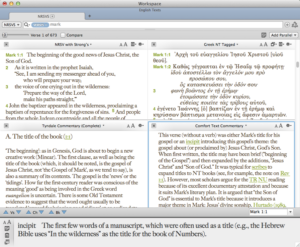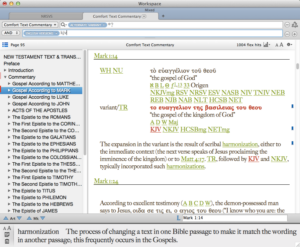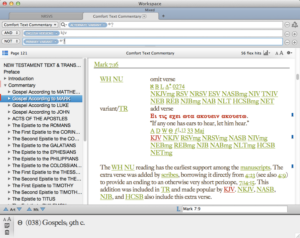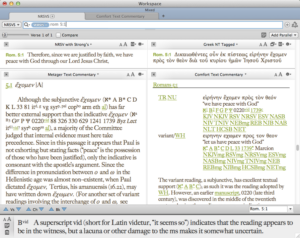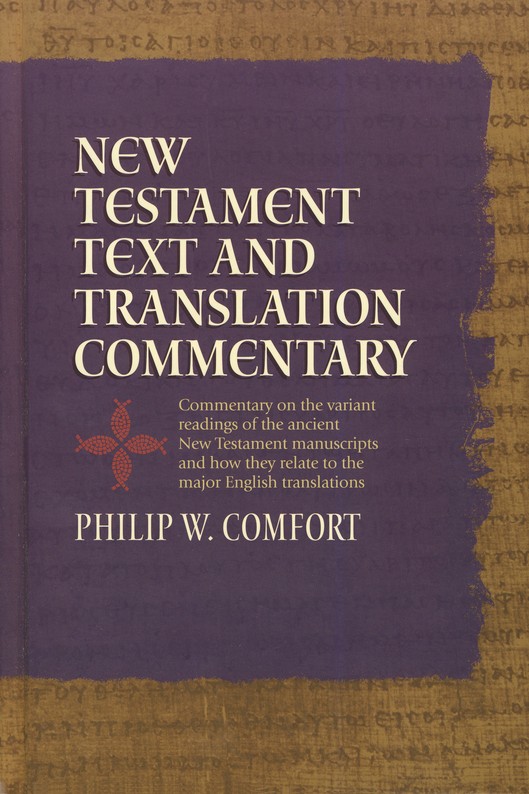
Ever wonder what to make of those footnotes in your English Bible which say, “Some manuscripts read…”? Those with little or no knowledge of the original languages of the Bible are often left with no way to answer the questions which naturally arise from such vague explanations. What does it mean that “ancient authorities” or “some manuscripts” omit words, phrases, or even entire verses of the Bible? Where there are other readings, why was one reading adopted over another? If you’re not an expert in New Testament textual criticism, how do you even find out?
It is for this reason that Philip Comfort embarked upon a fifteen-year project to explain every textual variation indicated in the notes of the major English versions of the Bible. He recounts an experience he encountered as a professor:
“… when one of my New Testament students at Wheaton College a number of years ago asked me, ‘Where is there a book that explains these textual variants?’ I had to tell him, ‘There isn’t one, really-unless you know Greek.'”1
“Since then,” he goes on to explain, “I have felt the need to provide such a book for English readers as well as for those who know Greek and are seeking information on how textual criticism might affect translation and exegesis.”2
We are proud to accompany Comfort in his quest to aid these readers by announcing the release of his New Testament Text and Translation Commentary (NTTTC). This commentary offers detailed explanations of the nearly three thousand textual notes that occur in the New Testament of the major English versions. In addition, it includes an introduction packed with useful information on textual criticism, the editions of the Greek New Testament, and a glossary of technical terms. Lastly, it includes four essays on textual criticism (Appendixes A-D).
The Accordance edition can be displayed in parallel with any New Testament text. It also offers several enhancements such as the ability to search multiple fields, instant hyperlinks which define all major manuscript symbols and technical terms, and over 200 links to other resources in your Library. Let’s take a look at these enhancements in more detail, as well as how it stacks up with the scholarly standard commentary in this field, Bruce M. Metzger’s, A Textual Commentary on the Greek New Testament (TCGNT).
Parallel Commentary
As with all of our Reference Tools, the NTTTC can be displayed in parallel with any Biblical text (NT in this case). Add an additional commentary or study Bible and you have a powerful reading workspace to aid in the crafting of your next sermon or Bible study.
Multi-field Searching
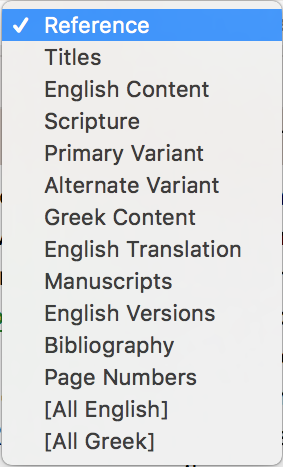
Before I show examples of the power of multi-field searching, let’s quickly look at the different fields in the NTTTC.
The first four fields: Reference, Titles, English Content, and Scripture are standard in every Reference Tool. The Bibliography and Page Numbers fields are self-explanatory as well. But the other fields are relatively unique, so I will briefly explain them:
- Primary Variant: contains the Greek text for the particular reading adopted by the majority of English translations. This field is prefaced by the version of the GNT that contains this text (WH, NU, or TR).
- Alternate Variant: contains the (unaccented) Greek text of the additional variants for that verse. These are usually numbered variant 1, 2, etc.
- Greek Content: contains Greek text in the commentary body, intro, or appendices.
- English Translation: contains the English translation for the Primary and Alternate Variants.
- Manuscripts: contains the manuscript symbols and witnesses that support a particular reading or are mentioned in the body of the commentary.3
- English Versions: Contains every reference to the English versions referenced in the commentary.
Now, let’s take a look at an example using multi-field searching.
In this screen shot I searched the Alternate Variant field for all content ( *? ), and added an extra field to search the English Versions field for KJV. Knowing that this would yield a lot of hits throughout the entire commentary, I disclosed the Browser contents and right-clicked on Mark to select that book as the range for my search (yielding 1,004 hits). This search approximately finds the instances in Mark where the KJV adopts a reading that is different from the majority of the English versions. (Note that this is not an exact search but with a minute amount of scanning you can easily detect irrelevant hits). In this example you can see that all the major English versions adopt the primary variant, except for the KJV and NKJV (although it does have the support of several important manuscripts A D W, in addition to Maj). Looking at the comment on this verse you can see that the variant is probably the result of scribal harmonization; a technical term which is defined in the glossary and instantly displayed in the Instant Details box upon hovering over it. You can also hover over any of the major manuscript witnesses and get instant information on its date and contents.
In another example of multi-field searching, you can see the precision with which you can search this resource.
Here I replicated the same search as before except that I added one more field, and searched for all Primary Variant content NOT in the same article. This search finds the five verses in Mark, which are omitted by the majority of English versions, but added in the KJV.
These are just a few of the types of searches you can perform, but already you can see the wealth of information that is accessible, and the relative ease of discovering it. Imagine how long it would take you to find just those five verses (or more if you expanded the search range to the synoptic gospels, Pauline epistles, or entire NT).
Metzger vs. Comfort
Bruce Metzger’s Textual Commentary on the Greek New Testament (2d ed; UBS: 1994) has long been heralded as the most detailed commentary that explains the inner workings of the translation committee’s decisions for the text of the United Bible Societies’ Greek New Testament (4th rev. ed.).4 However, for those without a basic understanding of Greek and textual criticism, this resource can be difficult to navigate. It also does not concentrate on indicating where the major English versions differ, or why.
This is where Comfort’s NTTTC shines. In addition to filling some of the same needs of the TCGNT (often with greater detail), it also provides information on which route the English translations take.5 Note the following example from Romans 5:1:
Both resources note that although the external support for ἔχωμεν (‘let us have…’) is greater than ἔχομεν (‘we have…’), the internal evidence makes more sense of Paul’s thought. However, Comfort gives more technical information on the manuscript evidence (including an extended discussion on the text of 0220), shows which route the English versions take, and provides complementary information on the greater weight of the internal evidence. All of this is accomplished in an easy to read, yet technically precise manner—sufficient for both the layperson and academic. And, because Comfort provided explanations of the manuscript witnesses and symbols, we were able to create instant hyperlinks to them. In addition, Comfort makes reference to the TCGNT over one hundred times in the commentary notes, and each of these is hyperlinked to the relevant verse of the TCGNT in Accordance, creating a seamless transition while investigating the text in both of these resources.
In the end, although I believe Comfort is the winner of this text-critical duel, both resources complement each other and make a perfect pair.
Conclusion
In this article I showed how Accordance takes the wealth of information in the NTTTC and makes it easily accessible. Multi-field searching makes it easy to perform complex searches and provides in-depth information that would otherwise take hours to unearth. Instant hyperlinks to manuscript symbols and technical terms save untold time in flipping to the introduction, while hyperlinks to other resources such as Metzger’s TCGNT creates a seamless transition from one resource to the other. Suited for anyone interested in the text of the New Testament, the NTTTC also pairs perfectly with a technical commentary such as the WBC or Hermeneia.
(Article images updated September 2013)
1 Philip W. Comfort, New Testament Text and Translation Commentary, Accordance electronic ed. (Wheaton: Tyndale House Publishers, 2008), vii.
2 Ibid.
3 This field uses our MSS font. For help using this font select the drop down menu: Window > Character Palette; or view the Accordance Fonts PDF.
4 The UBS4 contains the same text as the NA27.
5 Comfort was the New Testament textual critic for the translation committee of the New Living Translation.


